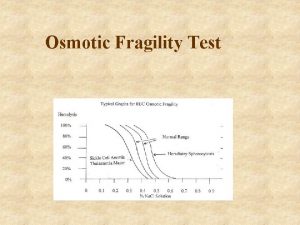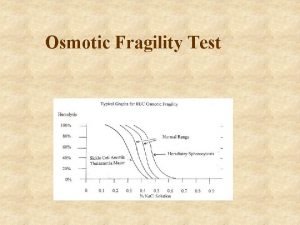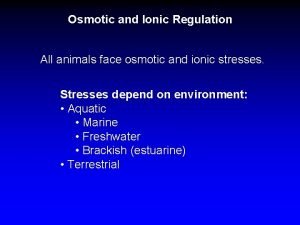Osmotic Fragility Test Osmotic fragility Definition Osmotic fragility












- Slides: 12

Osmotic Fragility Test

Osmotic fragility • Definition: – Osmotic fragility is a test to measures red blood cell (RBC) resistance to hemolysis when exposed to a series of increasingly dilute saline solutions. – The sooner hemolysis occurs, the greater the osmotic fragility of the cells. • Factors affect the osmotic fragility: 1. Cell membrane permeability. 2. Surface-to – volume ratio.

Why the Test is performed? • This test is performed to detect thalassemia and hereditary spherocytosis. • Hereditary spherocytosis is a common disorder in which red blood cells are defective because of their round, balllike (spherical) shape. These cells are more fragile than normal. • Spherical cells are said to have increased osmotic fragility because they are less likely to expand break open in salter water than normal red blood cells (which are indented or curved inward on both sides).

Why the Test is performed? • Cells that are flatter than normal are more likely to expand, and thus have decreased osmotic fragility. • Thalassemia is an inherited condition that affects the portion of blood (hemoglobin) that carries oxygen. • Some red blood cells are more fragile than normal, but a larger number are less fragile than normal. • When spherocytes (HS) are suspected on the basis of an elevated mean corpuscular hemoglobin concentration or on examination of a peripheral blood smear, the osmotic fragility test may be used to confirm the presence of spherocytes. • The test does not distinguish between spherocytes in HS and in acquired autoimmune hemolytic anemia.

Why the Test is performed? • The test only indicates that a proportion of the red cells have decreased surface-to-volume ratios and are more susceptible to lysis in hypo- osmotic solutions. • HS patients who are experiencing significant elevations in reticulocytes may not fall outside of the normal range. • Cells with increased surface-to-volume ratios, such as occur in thalassemia and iron deficiency, may show decreased osmotic fragility.

Why the Test is performed? • For patients with acute hemolysis, a normal red cell osmotic fragility test result cannot exclude an osmotic fragility abnormality since the osmotically labile cells may be hemolyzed and not present. • Recommend testing during a state of prolonged homeostasis with stable hematocrit.

• Osmotic fragility decreased in: – Thalassemia. – Iron deficiency anemia. – Sickle cell anaemia. • Osmotic fragility of red cells increased in: – Hereditary spherocytosis. – Acquired spherocytosis.

Osmotic Fragility Test • Purpose: 1 - To aid diagnosis of hereditary spherocytosis & Thalassemia. 2 - To supplement a stained cell examination to detect morphologic RBC abnormalities. • Material: – Specimen: whole blood – Collection Medium: Na Heparin tube or Lithium Heparin tube. – Minimum: 5 ml whole blood. – Rejection Criteria: Hemolyzed specimen. – Methodology: Spectrophotometer.

Procedure 1 - We will do this dilution: Test tube 1 2 3 1%Nacl(ml) D. W. (ml) Final conc. (%) 10. 0 8. 5 7. 5 0. 0 1. 5 2. 5 1. 00 0. 85 0. 75 4 5 6 7 8 9 10 11 12 13 14 6. 5 6. 0 5. 5 5. 0 4. 5 4. 0 3. 5 3. 0 2. 0 1. 0 0. 0 3. 5 4. 0 5. 50 6. 0 7. 0 8. 0 9. 0 10. 0 0. 65 0. 60 0. 55 0. 50 0. 45 0. 40 0. 35 0. 30 0. 20 0. 10 0. 00

Procedure 2 - Then we divide every volume in 2 tubes so now we get 28 tubes. 3 - Add 50 micron of whole blood to every tube. 4 - let the tubes at R. T for- 30 min at 2500 rpm. 5 - Well mixing by using the vortex. 6 - Centrifuge for 5 minutes at 2500 rpm. 7 - Now we will measure the absorbance in the tubes by using spectrophotometer (540 nm). 8 - calculate the % of hemolysis.

Result: • % of hemolysis = (Abs of tube / Abs of tube 14) * 100% • Normal Range: – Hemolysis begins 0. 45% and complete 0. 35%

Discussion • Interfering factors : 1 - Completely fill the collection tube and invert it gently several times to mix the sample and anticoagulant thoroughly. 2 - Handle the sample gently to prevent accidental hemolysis. 3 - In some cases, RBCs don't hemolysis immediately, incubation in solution for 141 hours improves test sensitivity. 4 - Presence of hemolytic organisms in the sample. 5 - Severe anemia or other conditions with fewer RBCs available for testing. 6 - Recent blood transfusion. 7 - Old sample.
 Describe osmotic fragility test
Describe osmotic fragility test Vertical
Vertical Describe osmotic fragility test
Describe osmotic fragility test Factors affecting osmotic fragility test
Factors affecting osmotic fragility test Osmotic fragility in thalassemia
Osmotic fragility in thalassemia Osmotic fragility
Osmotic fragility Osmotic fragility
Osmotic fragility Alendronate brand name
Alendronate brand name Why is water potential measured in pascals
Why is water potential measured in pascals Osmotic potential vs water potential
Osmotic potential vs water potential Serum osmolarity formula
Serum osmolarity formula Water potential equation
Water potential equation Osmotic communication in agile
Osmotic communication in agile



















